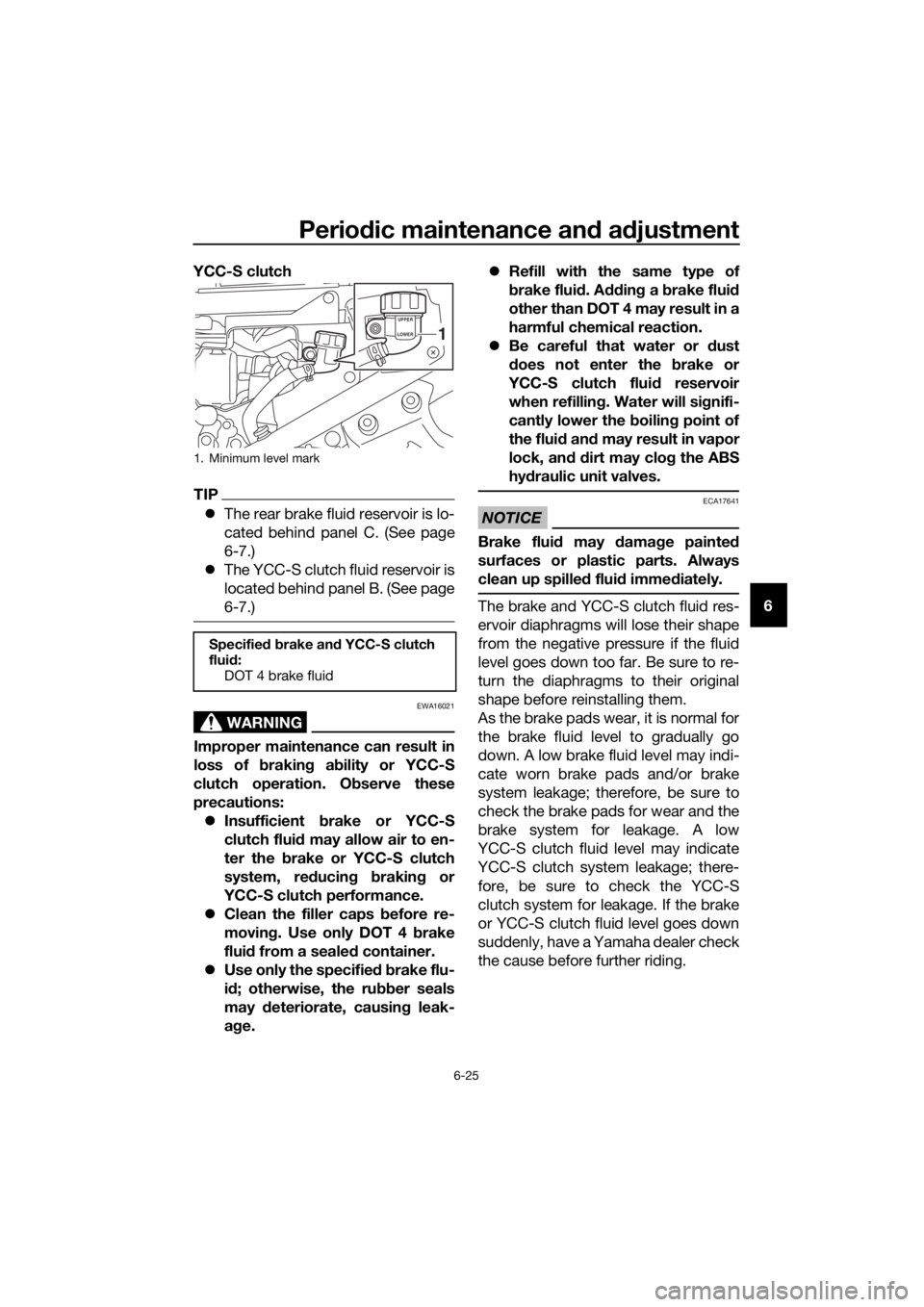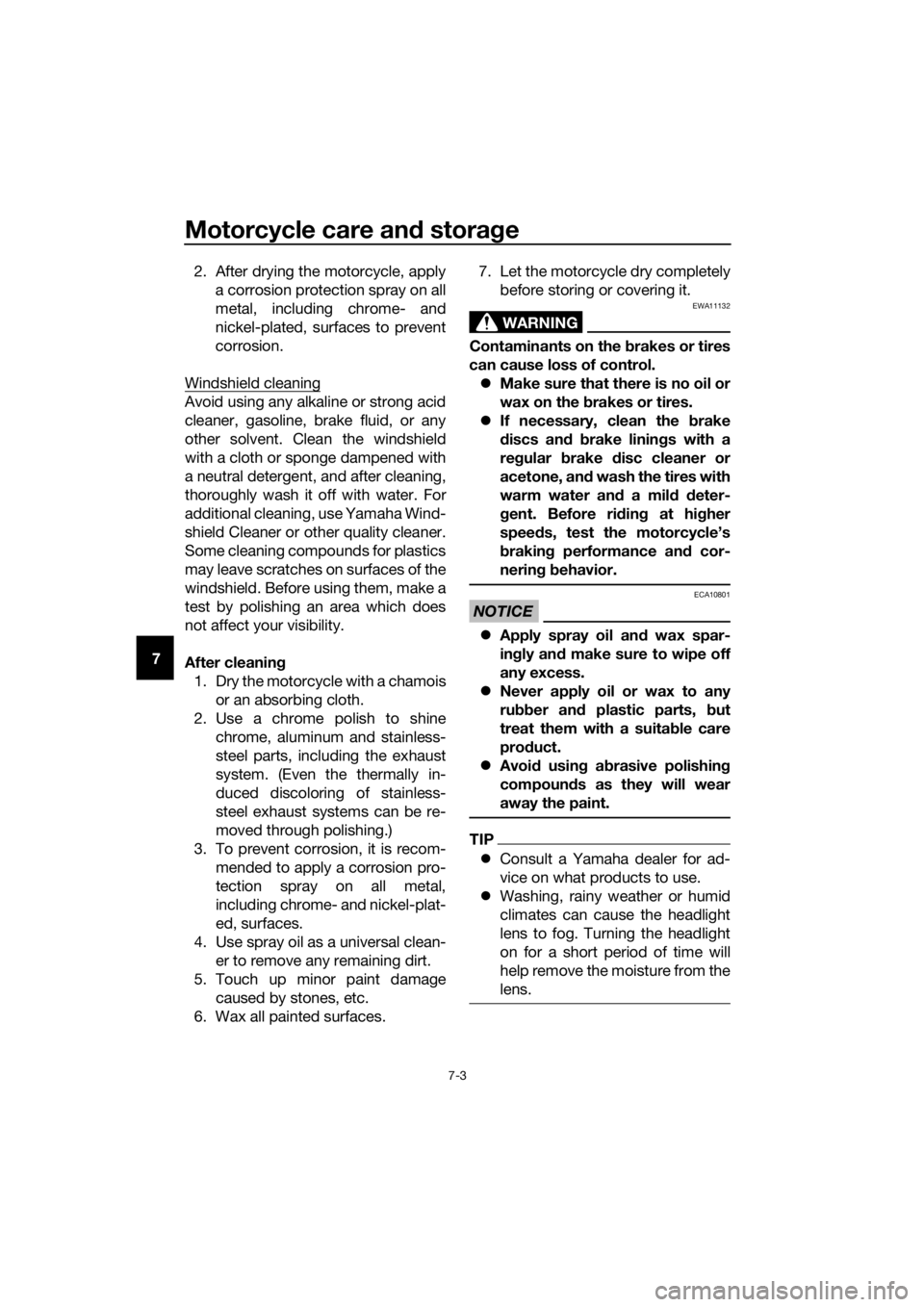2016 YAMAHA FJR1300AS brake fluid
[x] Cancel search: brake fluidPage 99 of 126

Periodic maintenance an d a djustment
6-25
6
YCC-S clutch
TIP
The rear brake fluid reservoir is lo-
cated behind panel C. (See page
6-7.)
The YCC-S clutch fluid reservoir is
located behind panel B. (See page
6-7.)
WARNING
EWA16021
Improper maintenance can result in
loss of brakin g a bility or YCC-S
clutch operation. O bserve these
precautions: Insufficient brake or YCC-S
clutch flui d may allow air to en-
ter the b rake or YCC-S clutch
system, re ducin g brakin g or
YCC-S clutch performance.
Clean the filler caps before re-
moving . Use only DOT 4 brake
flui d from a seale d container.
Use only the specified b rake flu-
i d ; otherwise, the ru bber seals
may deteriorate, causin g leak-
a g e.
Refill with the same type of
brake flui d. A ddin g a brake flui d
other than DOT 4 may result in a
harmful chemical reaction.
Be careful that water or dust
d oes not enter the brake or
YCC-S clutch flui d reservoir
when refillin g. Water will si gnifi-
cantly lower the b oiling point of
the flui d an d ma y result in vapor
lock,
an d d irt may clo g the ABS
hy draulic unit valves.
NOTICE
ECA17641
Brake flui d may d amage painte d
surfaces or plastic parts. Always
clean up spille d flui d imme diately.
The brake and YCC-S clutch fluid res-
ervoir diaphragms will lose their shape
from the negative pressure if the fluid
level goes down too far. Be sure to re-
turn the diaphragms to their original
shape before reinstalling them.
As the brake pads wear, it is normal for
the brake fluid level to gradually go
down. A low brake fluid level may indi-
cate worn brake pads and/or brake
system leakage; therefore, be sure to
check the brake pads for wear and the
brake system for leakage. A low
YCC-S clutch fluid level may indicate
YCC-S clutch system leakage; there-
fore, be sure to check the YCC-S
clutch system for leakage. If the brake
or YCC-S clutch fluid level goes down
suddenly, have a Yamaha dealer check
the cause before further riding.
1. Minimum level mark
Specified b rake an d YCC-S clutch
flui d:
DOT 4 brake fluid
UPPER
LOWER
1
UB95E0E0.book Page 25 Friday, February 19, 2016 2:15 PM
Page 100 of 126

Periodic maintenance an d a djustment
6-26
6
EAU40604
Chan gin g the brake an d
YCC-S clutch fluid s
Have a Yamaha dealer change the
brake and YCC-S clutch fluids at the
intervals specified in the periodic main-
tenance and lubrication chart. In addi-
tion, have the oil seals of the brake and
YCC-S clutch master cylinders and
calipers as well as the brake and
YCC-S clutch hoses replaced at the in-
tervals listed below or whenever they
are damaged or leaking.
Oil seals: Replace every two
years.
Brake and YCC-S clutch hoses:
Replace every four years.
EAU23098
Checkin g an d lu bricatin g the
ca bles
The operation of all control cables and
the condition of the cables should be
checked before each ride, and the ca-
bles and cable ends should be lubri-
cated if necessary. If a cable is
damaged or does not move smoothly,
have a Yamaha dealer check or re-
place it. WARNING! Dama ge to the
outer housin g of cab les may result
in internal rustin g an d cause inter-
ference with cab le movement. Re-
place damag ed cab les as soon as
possi ble to prevent unsafe con di-
tions.
[EWA10712]
Recommen ded lu bricant:
Yamaha cable lubricant or other
suitable cable lubricant
UB95E0E0.book Page 26 Friday, February 19, 2016 2:15 PM
Page 114 of 126

Motorcycle care and stora ge
7-3
7 2. After drying the motorcycle, apply
a corrosion protection spray on all
metal, including chrome- and
nickel-plated, surfaces to prevent
corrosion.
Windshield cleaning
Avoid using any alkaline or strong acid
cleaner, gasoline, brake fluid, or any
other solvent. Clean the windshield
with a cloth or sponge dampened with
a neutral detergent, and after cleaning,
thoroughly wash it off with water. For
additional cleaning, use Yamaha Wind-
shield Cleaner or other quality cleaner.
Some cleaning compounds for plastics
may leave scratches on surfaces of the
windshield. Before using them, make a
test by polishing an area which does
not affect your visibility.
After cleanin g
1. Dry the motorcycle with a chamois or an absorbing cloth.
2. Use a chrome polish to shine chrome, aluminum and stainless-
steel parts, including the exhaust
system. (Even the thermally in-
duced discoloring of stainless-
steel exhaust systems can be re-
moved through polishing.)
3. To prevent corrosion, it is recom- mended to apply a corrosion pro-
tection spray on all metal,
including chrome- and nickel-plat-
ed, surfaces.
4. Use spray oil as a universal clean- er to remove any remaining dirt.
5. Touch up minor paint damage caused by stones, etc.
6. Wax all painted surfaces. 7. Let the motorcycle dry completely
before storing or covering it.
WARNING
EWA11132
Contaminants on the brakes or tires
can cause loss of control. Make sure that there is no oil or
wax on the brakes or tires.
If necessary, clean the b rake
d iscs an d b rake linin gs with a
re gular brake disc cleaner or
acetone, an d wash the tires with
warm water an d a mil d d eter-
g ent. Before ri din g at hi gher
speed s, test the motorcycle’s
b rakin g performance an d cor-
nering b ehavior.
NOTICE
ECA10801
Apply spray oil an d wax spar-
in gly an d make sure to wipe off
any excess.
Never apply oil or wax to any
rubber an d plastic parts, but
treat them with a suitab le care
prod uct.
Avoi d using abrasive polishin g
compoun ds as they will wear
away the paint.
TIP
Consult a Yamaha dealer for ad-
vice on what products to use.
Washing, rainy weather or humid
climates can cause the headlight
lens to fog. Turning the headlight
on for a short period of time will
help remove the moisture from the
lens.
UB95E0E0.book Page 3 Friday, February 19, 2016 2:15 PM
Page 118 of 126

Specifications
8-2
8
2nd:1.722 (31/18)
3rd: 1.350 (27/20)
4th:
1.111 (30/27)
5th: 0.963 (26/27)
6th: 0.846 (22/26)
Chassis:
Frame type:Diamond
Caster angle: 26.0 °
Trail: 109 mm (4.3 in)
Front tire:
Type:Tubeless
Size: 120/70ZR17M/C (58W)
Manufacturer/model:
BRIDGESTONE/BT023F E
Rear tire:
Type: Tubeless
Size:
180/55ZR17M/C (73W)
Manufacturer/model: BRIDGESTONE/BT023R E
Loa din g:
Maximum load:
208 kg (459 lb)
(Total weight of rider, passenger, cargo
and accessories)
Tire air pressure (measure d on col d
tires):
1 person:
Front:
250 kPa (2.50 kgf/cm², 36 psi)
Rear: 290 kPa (2.90 kgf/cm², 42 psi)
2 persons: Front:250 kPa (2.50 kgf/cm², 36 psi)
Rear: 290 kPa (2.90 kgf/cm², 42 psi)
Front wheel:
Wheel type:Cast wheel
Rim size:
17M/C x MT3.50
Rear wheel:
Wheel type:Cast wheel
Rim size:
17M/C x MT5.50
Unifie d b rake system:
Operation:
Activated by rear brake
Front brake:
Type:
Hydraulic dual disc brake
Specified brake fluid: DOT 4
Rear brake:
Type:
Hydraulic single disc brake
Specified brake fluid: DOT 4
Front suspension:
Type:
Telescopic fork
Spring: Coil spring
Shock absorber: Hydraulic damper
Wheel travel:
135 mm (5.3 in)
Rear suspension:
Type:Swingarm (link suspension)
Spring:
Coil spring
Shock absorber: Gas-hydraulic damper
Wheel travel: 125 mm (4.9 in)
Electrical system:
System voltage:12 V
Ignition system: TCI
Charging system:
AC magneto
UB95E0E0.book Page 2 Friday, February 19, 2016 2:15 PM
Page 122 of 126

10-1
10
Index
A
ABS ....................................................... 3-29
ABS warning light ................................... 3-5
Accessory box ...................................... 3-39
Air filter element .................................... 6-17
Auxiliary DC jack ................................... 3-50
B
Battery .................................................. 6-31
Brake and shift pedals, checking and
lubricating ........................................... 6-27
Brake and YCC-S clutch fluid levels, checking ............................................. 6-24
Brake and YCC-S clutch fluids, changing ............................................. 6-26
Brake lever ............................................ 3-28
Brake lever, checking and lubricating ........................................... 6-28
Brake lever free play, checking............. 6-22
Brake light switches.............................. 6-23
Brake pedal........................................... 3-28
C
Cables, checking and lubricating ......... 6-26
Canister................................................. 6-11
Care ........................................................ 7-1
Catalytic converters .............................. 3-34
Centerstand and sidestand, checking and lubricating .................................... 6-28
Coolant ................................................. 6-15
Cornering lights .................................... 3-51
Cowling vents, opening and closing ..... 3-41
Cruise control indicator lights ................. 3-4
Cruise control switches ........................ 3-25
Cruise control system ............................. 3-8
D
Diagnostic connector.............................. 9-2
Dimmer/Pass switch ............................. 3-24
D-mode (drive mode) ............................ 3-23
E
Electronically adjustable suspension system warning light............................. 3-6
Engine break-in....................................... 5-6
Engine idling speed, checking .............. 6-17
Engine oil and oil filter cartridge ........... 6-11
Engine serial number .............................. 9-1
Engine trouble warning light ................... 3-5
F
Final gear oil.......................................... 6-14
Front and rear brake pads, checking.... 6-23
Front fork, checking .............................. 6-30
Fuel ....................................................... 3-32 Fuel consumption, tips for reducing ...... 5-5
Fuel tank cap ........................................ 3-31
Fuel tank overflow hose ....................... 3-33
Fuses, replacing ................................... 6-33
H
Handlebar position, adjusting .............. 3-40
Handlebar switches .............................. 3-24
Hand shift lever .................................... 3-27
Hazard switch....................................... 3-24
Headlight beams, adjusting.................. 3-40
High beam indicator light ....................... 3-4
Horn switch .......................................... 3-24
I
Identification numbers ............................ 9-1
Ignition circuit cut-off system............... 3-48
Immobilizer system ................................ 3-1
Immobilizer system indicator light.......... 3-7
Indicator lights and warning lights ......... 3-4
M
Main switch/steering lock....................... 3-2
Maintenance and lubrication, periodic ... 6-4
Maintenance, emission control
system.................................................. 6-3
Matte color, caution ............................... 7-1
Menu switch ......................................... 3-25
Model label ............................................. 9-1
Multi-function meter unit ...................... 3-11
N
Neutral indicator light ............................. 3-4
O
Oil level warning light ............................. 3-4
P
Panels, removing and installing.............. 6-7
Parking ................................................... 5-7
Part locations ......................................... 2-1
R
Rear suspension, lubricating ................ 6-29
Rear view mirrors ................................. 3-42
Rider seat height, adjusting.................. 3-36
S
Safety information .................................. 1-1
Seats .................................................... 3-34
Select switch ........................................ 3-25
Shift down indicator light ....................... 3-6
Shifting ................................................... 5-3
Shift pedal ............................................ 3-26
Sidestand ............................................. 3-47
Spark plugs, checking .......................... 6-10
Specifications ......................................... 8-1
Starting the engine ................................. 5-2
UB95E0E0.book Page 1 Friday, February 19, 2016 2:15 PM